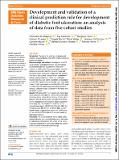Files in this item
Development and validation of a clinical prediction rule for the development of diabetic foot ulceration : an analysis of data from five cohort studies
Item metadata
| dc.contributor.author | Chappell, Francesca | |
| dc.contributor.author | Crawford, Fay | |
| dc.contributor.author | Horne, Margaret | |
| dc.contributor.author | Leese, Graham | |
| dc.contributor.author | Martin, Angela | |
| dc.contributor.author | Weller, David | |
| dc.contributor.author | Boulton, Andrew | |
| dc.contributor.author | Abbott, Caroline | |
| dc.contributor.author | Monteiro-Soares, Matilde | |
| dc.contributor.author | Veves, Aristidis | |
| dc.contributor.author | Riley, Richard | |
| dc.date.accessioned | 2021-05-26T10:30:02Z | |
| dc.date.available | 2021-05-26T10:30:02Z | |
| dc.date.issued | 2021-05-25 | |
| dc.identifier | 273779734 | |
| dc.identifier | 0998bbee-53ba-4d08-9291-622788be0a69 | |
| dc.identifier | 85106896947 | |
| dc.identifier | 000655123700001 | |
| dc.identifier.citation | Chappell , F , Crawford , F , Horne , M , Leese , G , Martin , A , Weller , D , Boulton , A , Abbott , C , Monteiro-Soares , M , Veves , A & Riley , R 2021 , ' Development and validation of a clinical prediction rule for the development of diabetic foot ulceration : an analysis of data from five cohort studies ' , BMJ Open Diabetes Research and Care , vol. 9 , no. 1 , e002150 . https://doi.org/10.1136/bmjdrc-2021-002150 | en |
| dc.identifier.issn | 2052-4897 | |
| dc.identifier.other | ORCID: /0000-0002-0473-9959/work/94669932 | |
| dc.identifier.uri | https://hdl.handle.net/10023/23253 | |
| dc.description | This independent research was funded by the UK National Institute for Health Research (NIHR) under its programme grants for health technology assessment scheme (15/171/01). | en |
| dc.description.abstract | Introduction The aim of the study was to develop and validate a clinical prediction rule (CPR) for foot ulceration in people with diabetes. Research design and methods Development of a CPR using individual participant data from four international cohort studies identified by systematic review, with validation in a fifth study. Development cohorts were from primary and secondary care foot clinics in Europe and the USA (n=8255, adults over 18 years old, with diabetes, ulcer free at recruitment). Using data from monofilament testing, presence/absence of pulses, and participant history of previous ulcer and/or amputation, we developed a simple CPR to predict who will develop a foot ulcer within 2 years of initial assessment and validated it in a fifth study (n=3324). The CPR’s performance was assessed with C-statistics, calibration slopes, calibration-in-the-large, and a net benefit analysis. Results CPR scores of 0, 1, 2, 3, and 4 had a risk of ulcer within 2 years of 2.4% (95% CI 1.5% to 3.9%), 6.0% (95% CI 3.5% to 9.5%), 14.0% (95% CI 8.5% to 21.3%), 29.2% (95% CI 19.2% to 41.0%), and 51.1% (95% CI 37.9% to 64.1%), respectively. In the validation dataset, calibration-in-the-large was −0.374 (95% CI −0.561 to −0.187) and calibration slope 1.139 (95% CI 0.994 to 1.283). The C-statistic was 0.829 (95% CI 0.790 to 0.868). The net benefit analysis suggested that people with a CPR score of 1 or more (risk of ulceration 6.0% or more) should be referred for treatment. Conclusion The clinical prediction rule is simple, using routinely obtained data, and could help prevent foot ulcers by redirecting care to patients with scores of 1 or above. It has been validated in a community setting, and requires further validation in secondary care settings. | |
| dc.format.extent | 7 | |
| dc.format.extent | 927658 | |
| dc.language.iso | eng | |
| dc.relation.ispartof | BMJ Open Diabetes Research and Care | en |
| dc.subject | RA0421 Public health. Hygiene. Preventive Medicine | en |
| dc.subject | NDAS | en |
| dc.subject | SDG 3 - Good Health and Well-being | en |
| dc.subject.lcc | RA0421 | en |
| dc.title | Development and validation of a clinical prediction rule for the development of diabetic foot ulceration : an analysis of data from five cohort studies | en |
| dc.type | Journal article | en |
| dc.contributor.institution | University of St Andrews. School of Medicine | en |
| dc.identifier.doi | 10.1136/bmjdrc-2021-002150 | |
| dc.description.status | Peer reviewed | en |
| dc.identifier.url | https://drc.bmj.com/content/9/1/e002150#supplementary-materials | en |
This item appears in the following Collection(s)
Items in the St Andrews Research Repository are protected by copyright, with all rights reserved, unless otherwise indicated.

